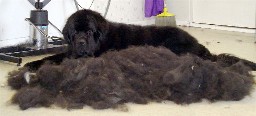Moulting facts for kids
Moulting (or molting) is the manner in which an animal routinely casts off part of its body (usually the outer layer or covering) at particular times of year, or at specific points in its life cycle. Moulting is also known as sloughing, shedding, or for some species, ecdysis.
Moulting can involve the epidermis (skin), and hair, fur, wool, or other external layer. In some species, other body parts may be shed, for example, wings in some insects. Examples include old feathers in birds, old hairs in mammals (especially dogs and other canidae), old skin in reptiles, and the entire exoskeleton in arthropods.
Contents
Examples

| Species | Item shed | Timing | Known as | Notes |
|---|---|---|---|---|
| Chickens | Feathers | Usually autumn | Moulting | Chickens generally stop laying eggs before their moulting begins, until their new set of feathers has grown back. |
| Dogs and other canids | Hair (Fur) | Semi-annually, spring and fall (autumn) | Shedding Moulting |
Moulting in canids, as in all mammals, is thought to be due to fluctuations in the amount of melatonin secreted by their pineal gland in response to seasonal sunlight variations. It has nothing to do with seasonal temperature variations. This seasonality in 'shed pattern' is most obvious in Arctic breeds of dogs that shed twice a year; other breeds now shed year round. |
| Snakes | Skin | Regularly, when old skin is outgrown | Moulting | Snakes will rub against rough surfaces to shed their skin. |
| Lizards | Skin | Regularly, when old skin is outgrown | Moulting | Lizards consume their shed skin for calcium, grooming, and other nutrients |
| Hermit crabs | Exoskeleton | Regularly, when the carapace is outgrown | Moulting | Land hermit crabs bury themselves for many weeks while they moult and consume their exoskeleton. |
| Amphibians | Skin | Regularly | Moulting | Salamanders and frogs shed their skins regularly, and often eat it. |
Ecdysis
In arthropods, such as insects, arachnids and crustaceans, moulting is the shedding of the exoskeleton (or shell).
This process of moulting is called ecdysis. It is the defining feature of a whole group of invertebrates, the clade Ecdysozoa. This group includes the arthropods, nematodes, velvet worms, horsehair worms, rotifers, tardigrades and Cephalorhyncha. Since the cuticles of these animals often forms an inelastic exoskeleton, it is shed during growth and a new, larger covering is formed. Amongst fossils, trilobites and eurypterida used ecdysis.
Ecdysis is part of the whole process of metamorphosis. The different stages (called 'instars') and the development of new 'apparatus' (such as sense organs) is necessary as the creature moves from one form to another. The new exoskeleton is initially soft but hardens after the moulting of the old exoskeleton.
Images for kids
-
A king penguin with developing replacement feathers, sometimes called pin feathers
-
A moulting yellow-eyed penguin
-
Giant prickly stick insect crawling out of his moulted skin
-
Discarded moult of a grasshopper (Caelifera)
-
Moult of a Tiliqua rugosa lizard, 5 cm scale bar
See also
 In Spanish: Muda (biología) para niños
In Spanish: Muda (biología) para niños













